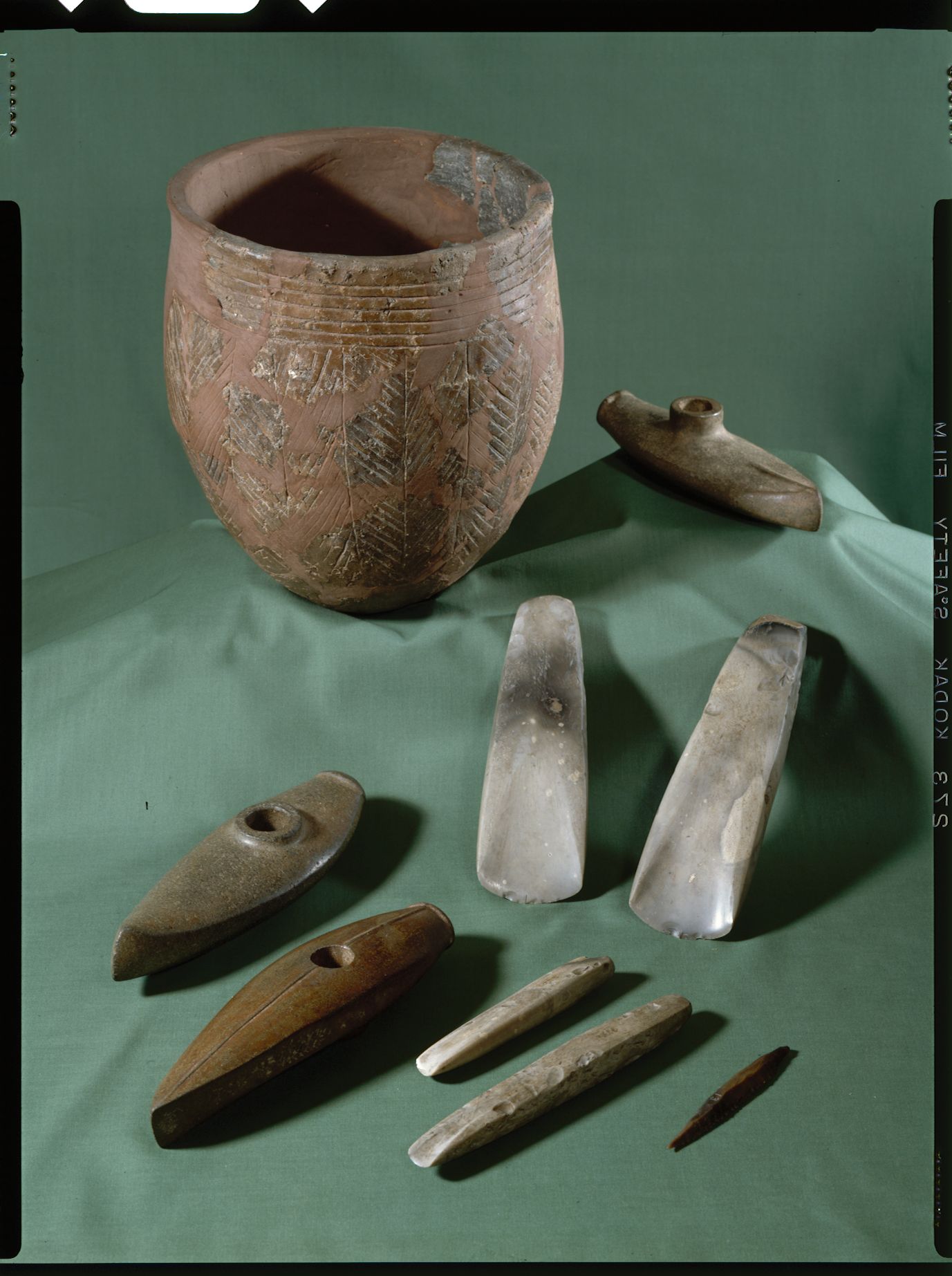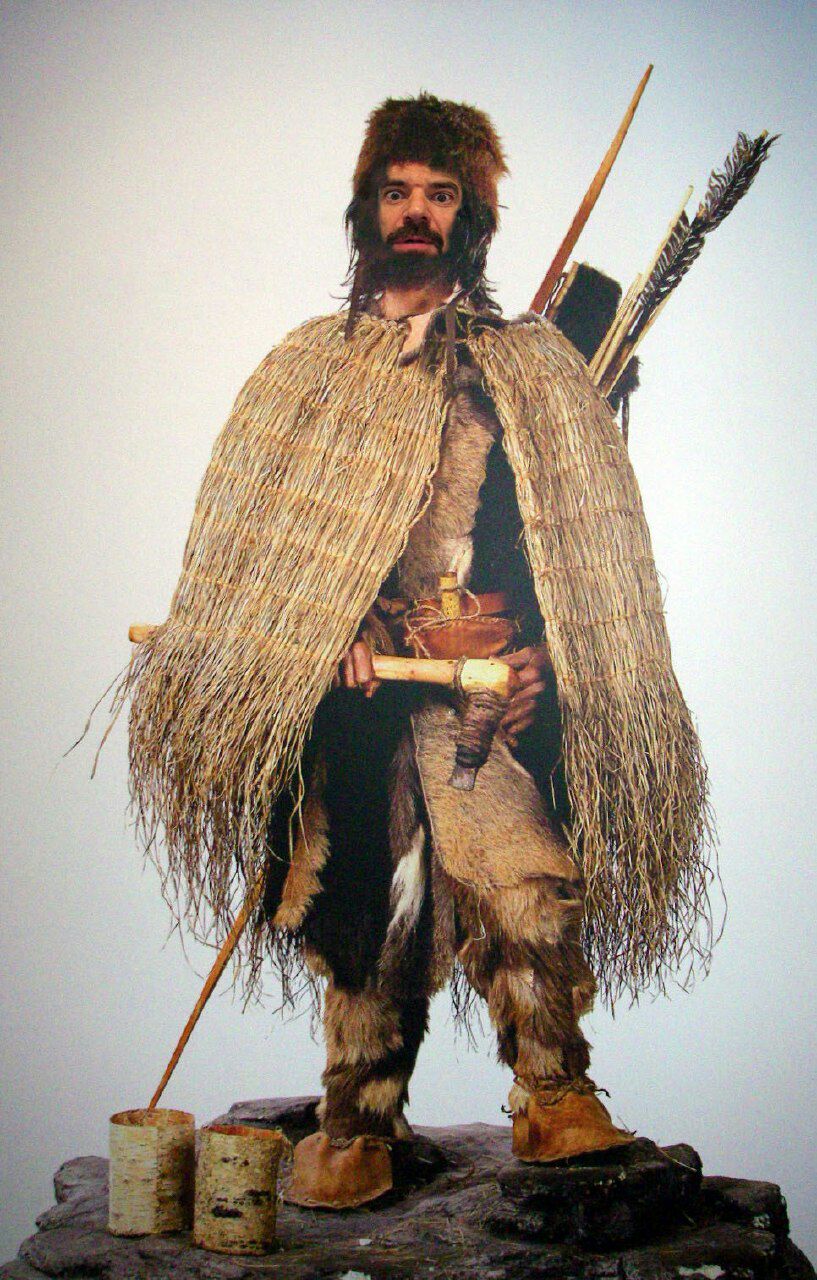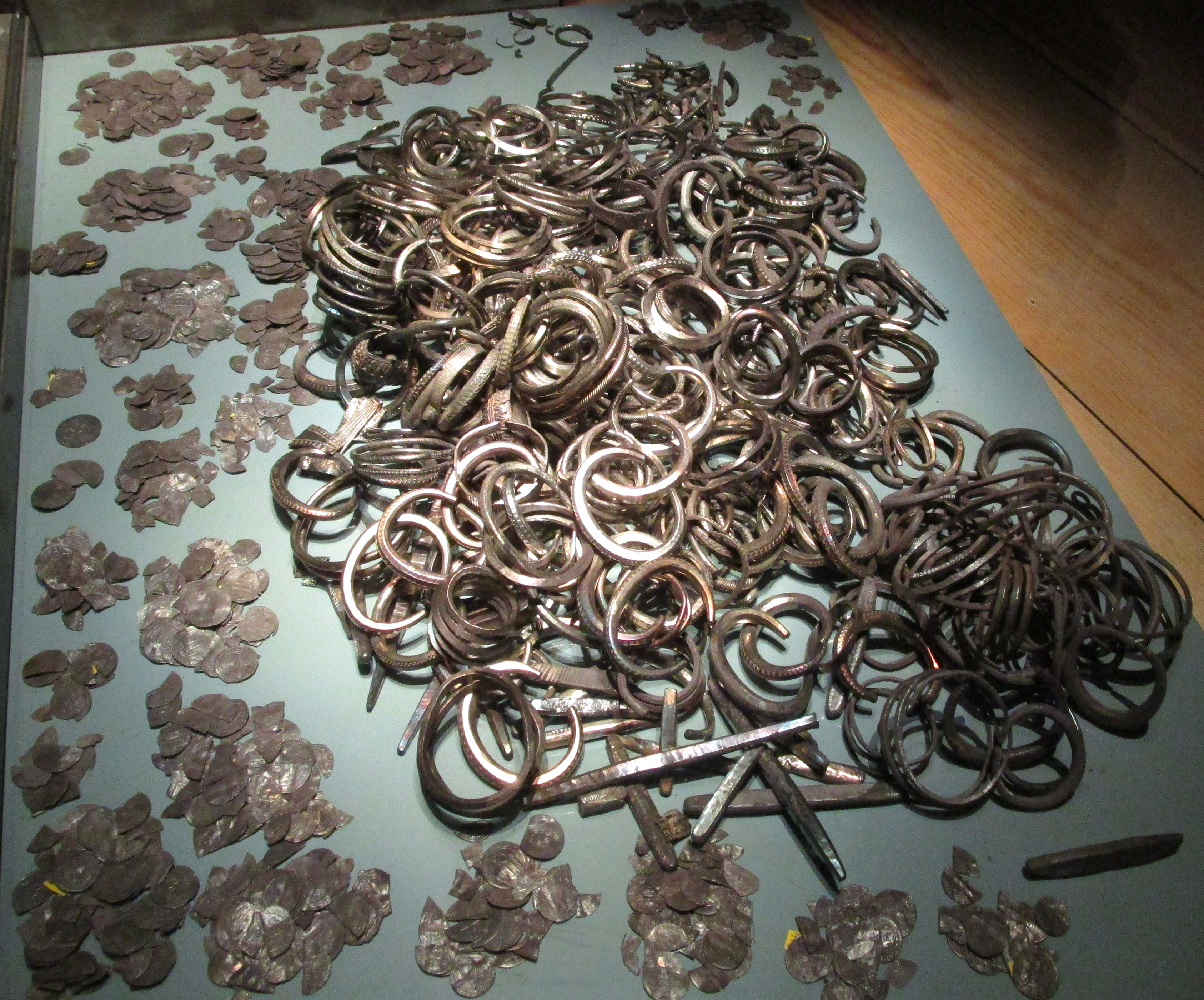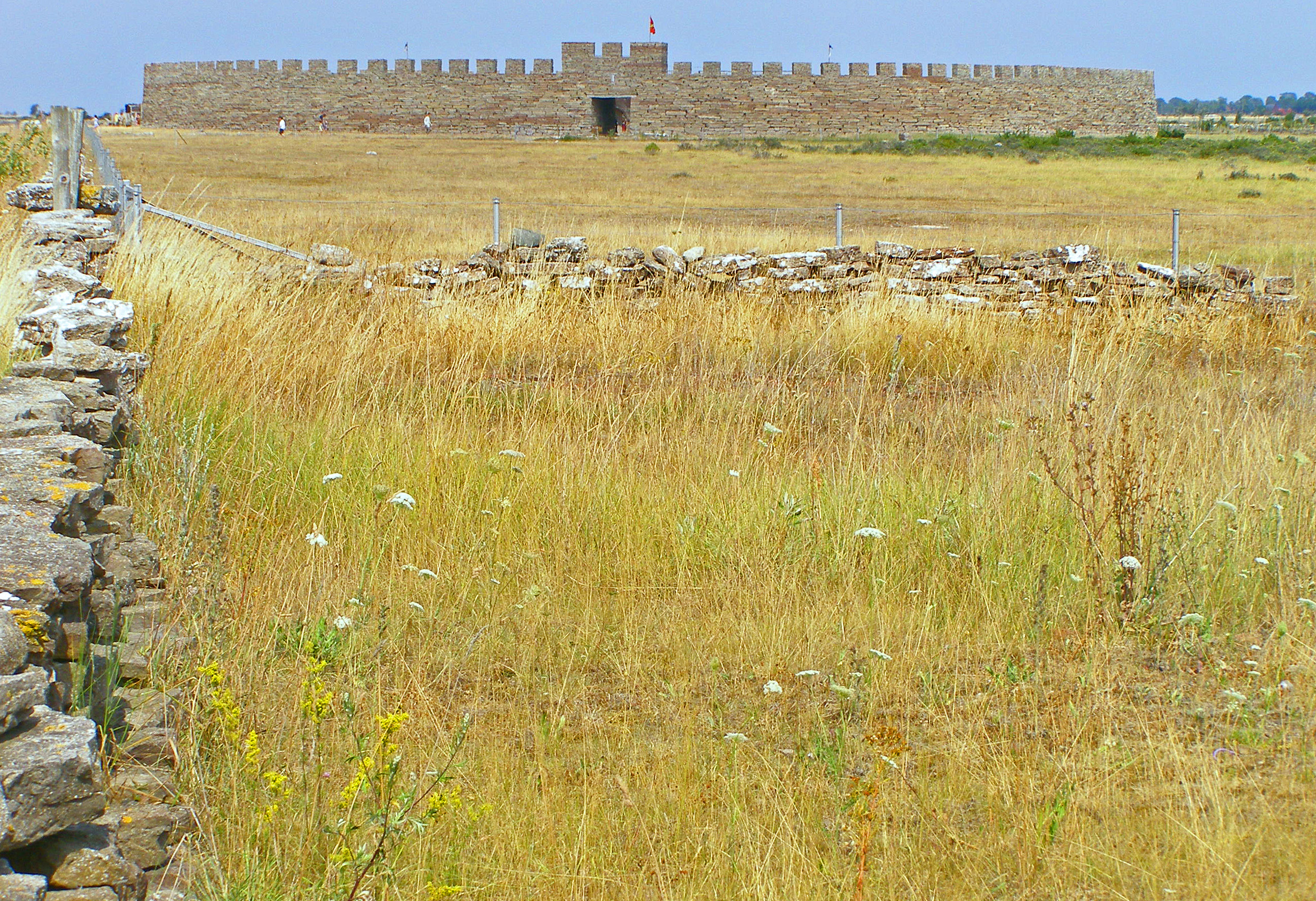|
Pitted Ware Culture
The Pitted Ware culture ( 3500 BC– 2300 BC) was a hunter-gatherer culture in southern Scandinavia, mainly along the coasts of Svealand, Götaland, Åland, north-eastern Denmark and southern Norway. Despite its Mesolithic economy, it is by convention classed as Neolithic, since it falls within the period in which farming reached Scandinavia. The Pitted Ware people were largely maritime hunters, and were engaged in lively trade with both the agricultural communities of the Scandinavian interior and other hunter-gatherers of the Baltic Sea. The people of the Pitted Ware culture were a genetically homogeneous and distinct population descended from earlier Scandinavian Hunter-Gatherers (SHGs). The culture emerged in east-central Sweden around 3,500 BC, gradually replacing the Funnelbeaker culture throughout the coastal areas of southern Scandinavia. It subsequently co-existed with the Funnelbeaker culture for several centuries. From about 2,800 BC, the Pitted Ware cultur ... [...More Info...] [...Related Items...] OR: [Wikipedia] [Google] [Baidu] |
Pit–Comb Ware Culture
The Comb Ceramic culture or Pit-Comb Ware culture, often abbreviated as CCC or PCW, was a northeast European culture characterised by its Pit–Comb Ware. It existed from around 4200 BCE to around 2000 BCE. The bearers of the Comb Ceramic culture are thought to have still mostly followed the Mesolithic hunter-gatherer ( Eastern Hunter-Gatherer) lifestyle, with traces of early agriculture. Distribution The distribution of the artifacts found includes Finnmark (Norway) in the north, the Kalix River (Sweden) and the Gulf of Bothnia (Finland) in the west and the Vistula River (Poland) in the south. It would include the Narva culture of Estonia and the Sperrings culture in Finland, among others. They are thought to have been essentially hunter-gatherers, though e.g. the Narva culture in Estonia shows some evidence of agriculture. Some of this region was absorbed by the later Corded Ware horizon. Ceramics The Pit–Comb Ware culture is one of the few exceptions to the rule that ... [...More Info...] [...Related Items...] OR: [Wikipedia] [Google] [Baidu] |
SГЎmi People
The SГЎmi ( ; also spelled Sami or Saami) are the traditionally SГЎmi languages, SГЎmi-speaking indigenous people inhabiting the region of SГЎpmi, which today encompasses large northern parts of Norway, Sweden, Finland, and of the Kola Peninsula in Russia. The region of SГЎpmi was formerly known as Lapland, and the SГЎmi have historically been known in English as Lapps or Laplanders, but these terms are regarded as offensive by the SГЎmi, who prefer their own endonym, e.g. Northern SГЎmi . Their traditional languages are the SГЎmi languages, which are classified as a branch of the Uralic language family. Traditionally, the SГЎmi have pursued a variety of livelihoods, including coastal fishing, fur trapping, and Shepherd, sheep herding. Their best-known means of livelihood is semi-nomadic reindeer herding. about 10% of the SГЎmi were connected to reindeer herding, which provides them with meat, fur, and transportation; around 2,800 SГЎmi people were actively involved in reindeer ... [...More Info...] [...Related Items...] OR: [Wikipedia] [Google] [Baidu] |
Östergötland
Östergötland (; English exonym: East Gothland) is one of the traditional provinces of Sweden (''landskap'' in Swedish) in the south of Sweden. It borders Småland, Västergötland, Närke, Södermanland and the Baltic Sea. In older English literature, the Latinized version ''Ostrogothia'' is also used. The corresponding administrative county, Östergötland County, covers the entire province and parts of neighbouring provinces. Heraldry From 1560, Östergötland was represented with two separate coats-of-arms seals until 1884, when the current one was granted. The coat of arms is represented with a ducal coronet. Blazon: " gules a griffin with dragon wings, tail and tongue rampant or armed, beaked, langued and membered azure between four roses argent." Geography From west to east, in the middle parts, extends the Östgöta Plain (''Östgötaslätten''). It is largely agricultural. In the southern part of the province, the terrain becomes marked by the south Swedish hi ... [...More Info...] [...Related Items...] OR: [Wikipedia] [Google] [Baidu] |
Alvastra Pile Dwelling
{{coord, 58, 17, N, 14, 41, E, display=title The Alvastra pile-dwelling (Swedish: ''Alvastra pålbyggnad'' or ''Alvastraboplatsen'') is a pile dwelling (also called a stilt house) from ca 3000 BC in Alvastra, Ödeshög Municipality, Östergötland County, Sweden. Southern Scandinavia has many types of cult centres, but the Alvastra pile dwelling is unique in Northern Europe and is the only of its kind outside of the Alpine Pile Dweller culture. It was the seasonal social and religious centre of a tribe that left objects from the Funnelbeaker culture, but pottery from the Pitted Ware culture, in the dwelling. After excavations in 1908–19, 1928–39 and 1976–80, two thirds of the site was surveyed by archaeologists. Construction The archaeologists found stilts made of deciduous trees, notably oak, hazel, elm and crabapple. A dendrochronological study showed that the construction had proceeded in two stages during 18 years, and after a break of 22 years, the work had been fin ... [...More Info...] [...Related Items...] OR: [Wikipedia] [Google] [Baidu] |
Corded Ware Culture
The Corded Ware culture comprises a broad archaeological horizon of Europe between – 2350 BC, thus from the Late Neolithic, through the Copper Age, and ending in the early Bronze Age. Corded Ware culture encompassed a vast area, from the contact zone between the Yamnaya culture and the Corded Ware culture in south Central Europe, to the Rhine in the west and the Volga in the east, occupying parts of Northern Europe, Central Europe and Eastern Europe. Autosomal genetic studies suggest that the Corded Ware culture originated from the westward migration of Yamnaya-related people from the steppe-forest zone into the territory of late Neolithic European cultures, evolving in parallel with (although under significant influence from) the Yamnaya; while the idea of direct male-line descent between them has not received significant support yet, IBD-sharing between the populations of these two cultures indicates that, at the very least, they came from a recent common ancestor ... [...More Info...] [...Related Items...] OR: [Wikipedia] [Google] [Baidu] |
Single Grave Culture
The Single Grave culture () was a Chalcolithic culture which flourished on the western North European Plain from ca. 2,800 BC to 2,200 BC. It is characterized by the practice of single burial, the deceased usually being accompanied by a battle axe, amber beads, and pottery vessels. The Single Grave culture was a local variant of the Corded Ware culture, and appears to have emerged as a result of a migration of peoples from the Pontic–Caspian steppe. It was succeeded by the Bell Beaker culture, which according to the "Dutch model" appears to have been ultimately derived from the Single Grave culture. More recently, the accuracy of this model has been questioned. History Origins The Single Grave culture was an offshoot of the Corded Ware culture, which was itself an offshoot of the Yamnaya culture of the Pontic–Caspian steppe. On the western North European Plain, the Single Grave culture replaced the earlier Funnelbeaker culture. Distribution The Single Grave culture came to en ... [...More Info...] [...Related Items...] OR: [Wikipedia] [Google] [Baidu] |
Prehistoric Warfare
Prehistoric warfare refers to war that occurred between societies without recorded history. The existence—and the definition—of war in humanity's hypothetical state of nature has been a controversial topic in the history of ideas at least since Thomas Hobbes in ''Leviathan'' (1651) argued a "war of all against all", a view directly challenged by Jean-Jacques Rousseau in a '' Discourse on Inequality'' (1755) and ''The Social Contract'' (1762). The debate over human nature continues, spanning contemporary anthropology, archaeology, ethnography, history, political science, psychology, primatology, and philosophy in such divergent books as Azar Gat's ''War in Human Civilization'' and Raymond C. Kelly's ''Warless Societies and the Origin of War''. For the purposes of this article, "prehistoric war" will be broadly defined as a state of organized lethal aggression between autonomous preliterate communities. Paleolithic Some scientists argue that humans have a predisposit ... [...More Info...] [...Related Items...] OR: [Wikipedia] [Google] [Baidu] |
Palisade
A palisade, sometimes called a stakewall or a paling, is typically a row of closely placed, high vertical standing tree trunks or wooden or iron stakes used as a fence for enclosure or as a defensive wall. Palisades can form a stockade. Etymology ''Palisade'' derives from ''pale'', from the Latin word ', meaning stake, specifically when used side by side to create a wood defensive wall. In turn, ''pДЃlus'' derives from the Old Italic word ''palЕ«ts'', which may possibly derive from the Proto-Indo-European word ''pelh'', meaning pale or gray. It may be related to the Proto-Uralic word ''pil'me'' (uncertain meaning) or the word ''pilwe'', meaning cloud. (see wikt:pale#Etymology_2, 'pale', English: Etymology 2 on Wiktionary). Typical construction Typical construction consisted of small or mid-sized tree trunks aligned vertically, with as little free space in between as possible. The trunks were sharpened or pointed at the top, and were driven into the ground and sometimes rein ... [...More Info...] [...Related Items...] OR: [Wikipedia] [Google] [Baidu] |
Finland
Finland, officially the Republic of Finland, is a Nordic country in Northern Europe. It borders Sweden to the northwest, Norway to the north, and Russia to the east, with the Gulf of Bothnia to the west and the Gulf of Finland to the south, opposite Estonia. Finland has a population of 5.6 million. Its capital and largest city is Helsinki. The majority of the population are Finns, ethnic Finns. The official languages are Finnish language, Finnish and Swedish language, Swedish; 84.1 percent of the population speak the first as their mother tongue and 5.1 percent the latter. Finland's climate varies from humid continental climate, humid continental in the south to boreal climate, boreal in the north. The land cover is predominantly boreal forest biome, with List of lakes of Finland, more than 180,000 recorded lakes. Finland was first settled around 9000 BC after the Last Glacial Period, last Ice Age. During the Stone Age, various cultures emerged, distinguished by differen ... [...More Info...] [...Related Items...] OR: [Wikipedia] [Google] [Baidu] |
Gotland
Gotland (; ; ''Gutland'' in Gutnish), also historically spelled Gottland or Gothland (), is Sweden's largest island. It is also a Provinces of Sweden, province/Counties of Sweden, county (Swedish län), Municipalities of Sweden, municipality, and List of dioceses, deaneries and parishes of the Church of Sweden, diocese. The province includes the islands of Fårö and Gotska Sandön to the north, as well as the Karlsö Islands (Lilla Karlsö, Lilla and Stora Karlsö, Stora) to the west. The population is 61,023 (2024) of which about 23,600 live in Visby, the main town. Outside Visby, there are minor settlements and a mainly rural population. The island of Gotland and the other areas of the province of Gotland make up less than one percent of Sweden's total land area. The county formed by the archipelago is the second smallest by area and is the least populated in Sweden. In spite of the small size due to its narrow width, the driving distance between the furthermost points of the ... [...More Info...] [...Related Items...] OR: [Wikipedia] [Google] [Baidu] |
Г–land
Öland (, ; ; sometimes written ''Oland'' internationally) is the second-largest Swedish island and the smallest of the traditional provinces of Sweden. Öland has an area of and is located in the Baltic Sea just off the coast of Småland. The island has over 26,000 inhabitants. It is separated from the mainland by the Kalmar Strait and connected to it by the Öland Bridge, which opened on 30 September 1972. The county seat Kalmar is on the mainland at the other end of the bridge and is an important commercial centre related to the Öland economy. The island's two municipalities are Borgholm and Mörbylånga named after their municipal seats. Much of the island is farmland, with fertile plains aided by the mild and sunny weather during summer. Öland does not have separate political representation at the national level, and is fully integrated into Sweden as part of Kalmar County. Administration The traditional provinces of Sweden no longer serve administrative or ... [...More Info...] [...Related Items...] OR: [Wikipedia] [Google] [Baidu] |







